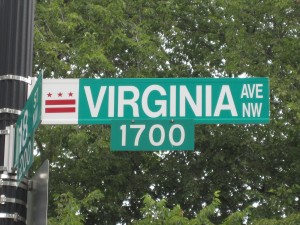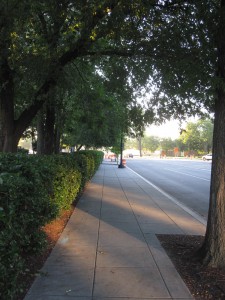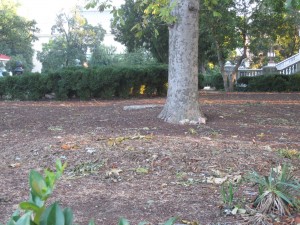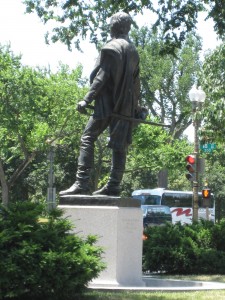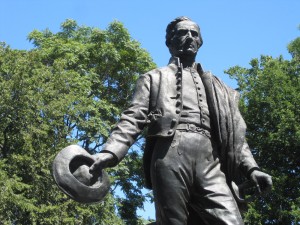Among the Liberators – Introduction
All of a sudden you’re there, among the Liberators on Virginia Avenue. The slight turn off Constitution is so gradual, so subtle that, even after the scores of walks I’ve taken along this street, I’m always surprised to have arrived. The broad, soaring trees prophesy much of the time you will spend on Virginia, a street lined and surrounded by scores of majestic old trees. Somehow the whole street feels grand, mature, seasoned, not fresh and inexperienced, yet not yet decrepit and irrelevant. Here at the 1700 block, this sage avenue welcomes any and every alert walker, inviting one and all to discover her delights.
You could call this street Washington’s Avenue of the Americas, a broad, attractive way that celebrates the culture and history, art and people of the Western Hemisphere, North and South America. From the captivatingly beautiful House of the Americas, the Organization of American States’ headquarters at the beginning, to the five statues of the Liberators standing at points along the way, to Robert Owen Latham Park, a wonderfully landscaped green area that honors the first Senator from Oklahoma, a man of mixed Cherokee ancestry who sponsored the Federal Reserve Act, to the Pan American Health Organization building, it is hard to walk along this way without being reminded of the New World. In a larger sense, Virginia Avenue also bears witness to both the overthrow of abused power and the freeing of its victims. Liberators assumes an object: the liberated.
Such high history, such lofty ideals are set, appropriately, on a street lined with soaring, spreading, venerable old trees though now, for reasons I will never know, one less than a few months ago when I first began gathering ideas and doing research for this travelogue. On your right, as soon as you make that gradual turn onto Virginia you can see over a hedge the Organization of American States’ headquarters sculpture garden. As I was first becoming acquainted with Virginia Ave., I was impressed that its subtle start was cool and shaded, the sidewalk overhung with ponderous branches. Now, a large patch of light punctuates the shade. Where the tree that shaded this spot once stood on your right you can see a mound, the only memorial, a grave of sorts, to a fine old tree that coolly shadowed this spot. I hope it truly needed to go, was either diseased or dying and carried the risk of falling branches. I miss even one less tree.
Take a look at a map of the street. (Map of Virginia Avenue) Washington’s layout includes, among the usual horizontals and verticals, diagonal streets. If you take a larger view of the map you can see that some of the diagonals, like Georgia or Pennsylvania, start in the heart of town and extend all the way to the Beltway and sometimes beyond. Others, like Virginia, are short, connecting one street with another. A far-distant, non-contiguous part of our Virginia Avenue runs through the southeast section of town but it’s not a part of our subject here. Notice on the map how a diagonal street will create all sorts of unusual intersections and shapes of blocks. Across the street from this spot next to the sculpture garden, you see an example of a triangular block, the product of the diagonal intersecting a horizontal and vertical street within the same, short space. Triangle blocks and odd intersections lend this street charm and interest.
On that small, odd block across from the sculpture garden, commanding it and everything he sees, looking south toward the rest of the hemisphere and toward the country he freed from colonial rule, stands Jose Gervasio Artigas, the first of the five Liberators whose statues live on this street. As you look across, you notice that General Artigas’ back is toward you. It’s not as if he is ignoring Virginia Avenue and its pedestrians exploring the Americas’ history and culture, but rather leading them, leading us all on, into some future quest to free the oppressed.
Walk along Virginia to 18th street, cross to the small triangular block, and walk around to stand before the statue. He’s peering off into the distance, eyes focused on some distant thing. Maybe he’s looking wistfully at the independent Uruguay he was not a part of. After laying the groundwork for a free nation, he was caught between larger powers (Portugal in Brazil, Spain, and Argentina) and lived the rest of his life, thirty years, exiled in Paraguay.
Artigas was a teenager during the American Revolution. I wonder what he knew of that struggle. I also wonder what he knew about how the fledgling United States decided to organize itself. Perhaps he hadn’t heard much about it, but was influenced by the thinkers and philosophers who impressed our Founding Fathers. I ask, because after he won an early victory for the group of provinces that would become Uruguay, he established a system of balanced power between the central and provincial governments, a federal system like ours. For his visionary work, the world recognizes him as a Liberator, the Father of Uruguayan Independence. I admire people driven by an ideal, a principle, an unseen and maybe as yet unrealized goal, who tirelessly work to make it happen. He is a good fellow to meet at the beginning of this walk.

